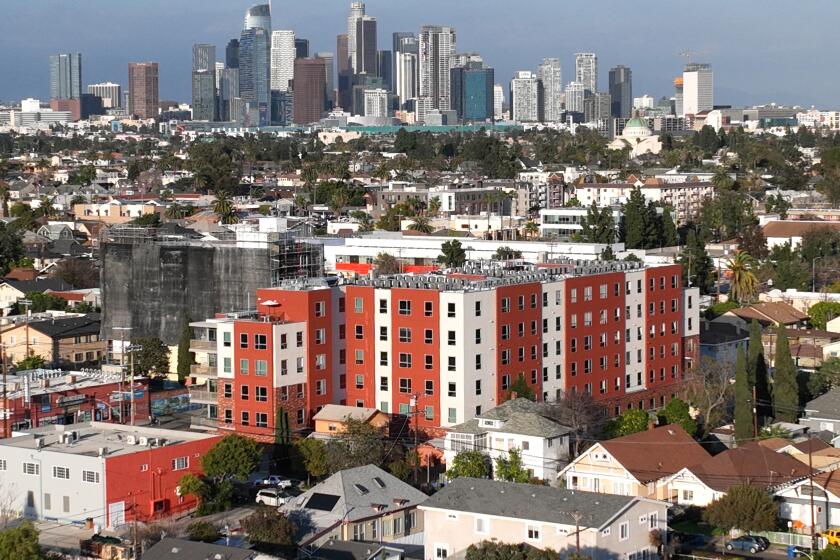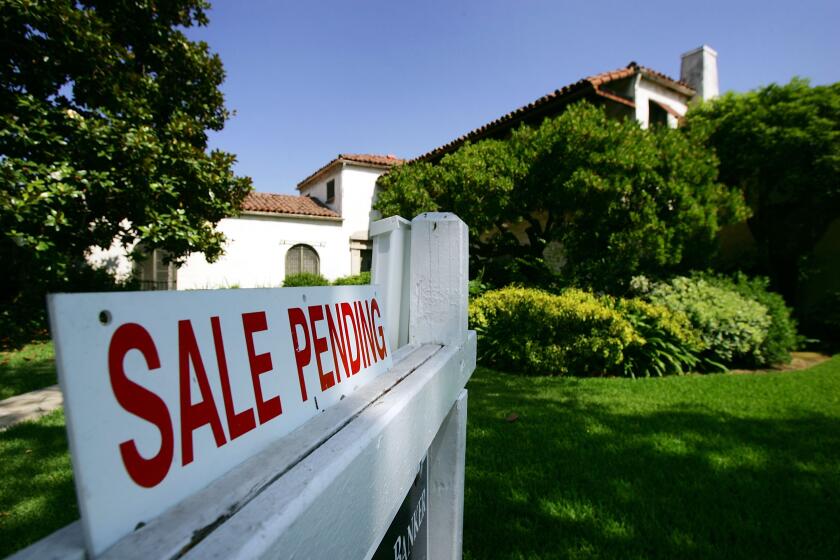Moody cottages in Montecito, Santa Barbara
- Share via
Larry and Donna Mason smile like indulgent parents as they recount a litany of what Larry calls “unexpected architectural features” but what others might consider faults in their historic Montecito cottage: Two doors on the narrow upstairs landing open into each other. A beam at the top of the stairs is too low, as Larry knows from painful experience. Built-in shelves are set too close together for many books to stand upright.
This little home — with its windows and doors of seemingly every size, its sharply slanted ceilings, its oddly shaped office— reflects a style that might best be called individualistic. Larry Mason, a retired engineer who knows something about straight lines and precise angles, puts it more bluntly: “It’s as asymmetrical as hell,” he says.
And he and his wife couldn’t be happier.
The Masons own a Moody cottage. An estimated three dozen of these pixie homes, most built in the 1930s and ‘40s, dot Santa Barbara and Montecito. The houses are a legacy left by four free-spirited Moody sisters.
Owners of Moody cottages today dote on their whimsical homes and forgive the inconveniences that come with the eccentricities. They love the odd mish-mash of recycled house parts and adore the enchanted gardens — all part of the vision of Harriet, Mildred, Brenda and Wilma.
Born in the 1890s, the sisters pioneered a style of property development that was ahead of its time. By combining their varied training and talents, they provided a complete package: Between them they could design and engineer the cottage, arrange financing, navigate planning issues, handle real estate transactions and decorate interiors.
The sisters made full use of windows, beams, doors and other house parts salvaged from large homes being torn down after the Depression to save on property taxes. These recycling efforts only lent their already fanciful creations another charmingly random dimension.
Today these cottages — mere doll’s houses when compared with Montecito mansions — continue to command serious money. Three Moody cottages recently were listed at $1,695,000 to $2,595,000, putting their price per square foot about 20% higher than the average 2009 per-square-foot sales price for other properties in the same ZIP Code.
Montecito Realtor Teddy Meyer of Coldwell Banker says that with the supply so limited, the cottages are “almost like a collectible” and that buyers are willing to pay extra for the charm and the cachet of history. Though he would not put a dollar figure on that premium, Meyer said prospective buyers in the area could get more house for the same money as a Moody cottage.
So, what sorts of buyers opt for a Moody home? People with the “whimsy gene,” according to Brook Ashley of Prudential California Realty in Montecito.
“There’s an element of magic in what the Moody sisters did, a little bit of whimsy in each home,” she says. “People fall in love with these places and treasure them.”
With names such as Hollyhock, Sweetbriar and Greencote, these cute, colorful little homes and gardens seem straight out of an English fairy tale; several still contain the Moodys’ signature glass jars of pins and needles, often cemented into the hearth, that were said to ward off mischievous fairies.
Marcia Gamble Hadley, a Seattle architect and great-niece of the Moodys, is writing a book about them. As a child, her mother spent summers with the sisters, the last of whom, Mildred, was almost 100 when she died in 1996.
Hadley is collecting early photos of the four remarkable sisters and their cottages, tracking down hand-drawn blueprints, researching construction and talking to owners. She’s also hiring a photographer to document the surviving homes, some of which are in their original configuration, some of which have undergone major remodels or additions.
She hopes her book will answer a couple of key questions: “Why are the tiny spaces that Moody cottages knit together so compelling?” she asks. “And what are the elements that make these small houses so enduring?”
Hadley has her own answers. If you simply want 2,400 square feet and walk-in closets, you don’t consider these houses. “On the other hand, if you want something that speaks to you, in the house and its relationship to the outdoors, if you yearn for something deeply satisfying,” she says, “then a Moody cottage is very likely to appeal.”
The Masons’ three-bedroom home stands on about a third of an acre with a distant ocean view. In 1976, they instantly fell in love with the cottage, made an offer and paid what they felt was a high price then: $112,000.
Christine Hoehner bought her two-bedroom, 1,200-square-foot Moody cottage about five years ago. She lives there with her dog, Emily Dickinson, and ticked off the reasons why it’s special: history, character, magic, charm. …
“It’s not linear, not sophisticated,” she says. “But it is charming and cozy, very homey and very comfy. I like ‘English’ and I like gardening. And I love lots of nooks and crannies.”
The key for Albert Martin is the simplicity of his 800-square-foot, one-bedroom, one-bathroom cottage on Periwinkle Lane. Now retired from the title insurance business, he has lived about 30 years in what was originally the guest cottage for a larger Moody home next door. Martin says he has tackled renovations in bits and pieces over the years and reckons there’s always something needing repair. Without insulation, the house gets chilly in winter, he says, but it’s home.
Builders today couldn’t reproduce Moody cottages even if they wanted to do so because low headroom and narrow stairways and other eccentricities would run afoul of building codes, says Brian Hofer, an architect and past president of the Architectural Foundation of Santa Barbara. He once rented a Moody cottage for about a year. He says the homes may be inefficient, but that’s the point. Moody cottages, Hofer says, make “the efficient house look kind of boring.”
More to Read
Sign up for Essential California
The most important California stories and recommendations in your inbox every morning.
You may occasionally receive promotional content from the Los Angeles Times.






